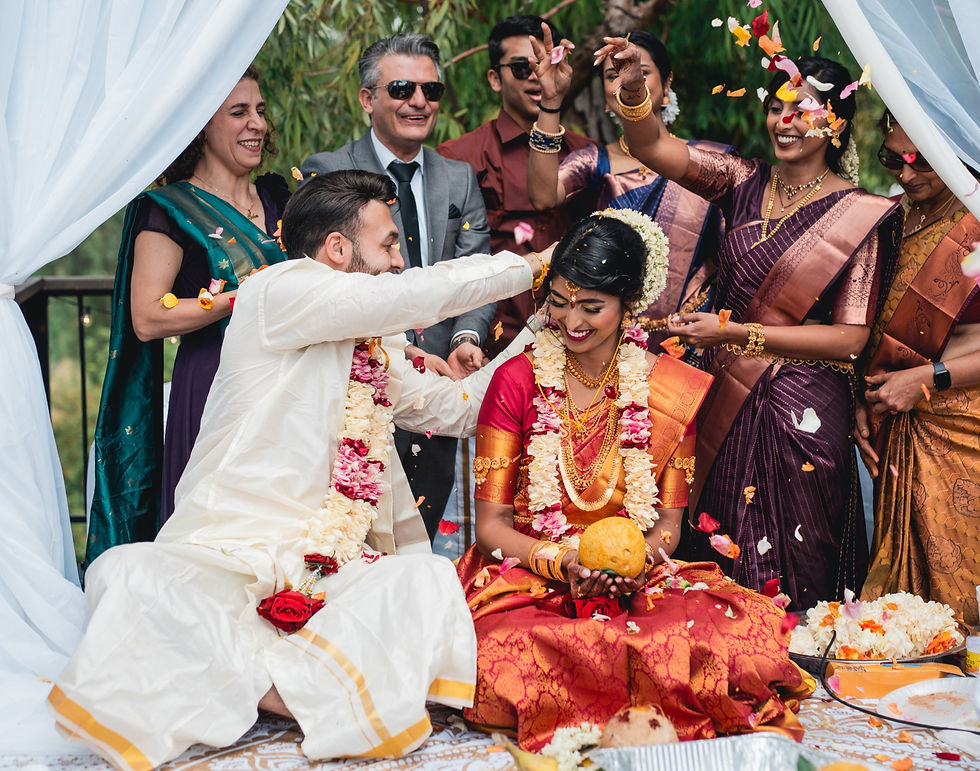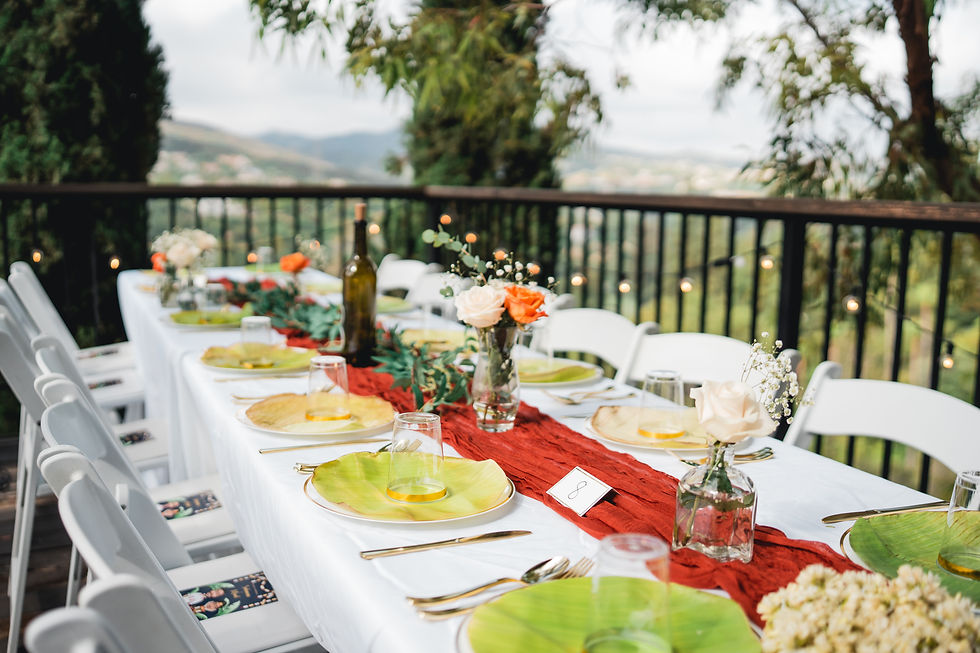Our Indian-Persian Wedding Debriefed: Part 1 - The Vision
- Sahaana Uma
- Mar 7, 2024
- 5 min read
Updated: May 22, 2024
After a grueling year and a half of updating spreadsheets till 2am, rush-orders from Etsy, and enough DIY décor projects to create a permanent aversion to Goo Gone, we successfully hosted our Indian-Persian wedding last June. While I can now (begrudgingly) admit that the end result was worth the stress of wedding planning, the experience was so draining that it’s taken me nine months to feel ready to unpack it. One of the hardest things about planning our Indian-Persian-American wedding was having no clue where to start. Were we really going to say personal vows about much we love each other and kiss in front of our family after years of barely acknowledging our relationship in front of them? Would our guests wear saris or gowns? What if all the food we serve ends up being too spicy or intimidating for our American guests? Between both sides of our families having no experience with planning a wedding in the U.S. and a general lack of inspiration/resources for mixed-culture weddings that still uphold traditional aspects of both sides, we were lost.

I decided that regardless of how the wedding turned out, if I was going to go through the hassle of figuring this all out on my own, I should share my experience with the hopes that it helps some newly engaged couple out there feel a little more equipped and inspired to go through this process than we did or at the very least, know that they’re not alone in experiencing pre-wedding burnout and temptation to scrap the whole thing. I meant to write this post last summer but once the wedding was over and I came back from the honeymoon, I could not bring myself to revisit the chaotic stress of the planning phase. So here I am, almost approaching our one year anniversary and I’m finally ready to share my experience.

When I was proposed to, my first thought was “how the hell are we going to pull off a mixed wedding that’s actually our style and respects tradition but doesn’t offend anyone?” (Actually my first thought was “It’s about damn time” because I was completely fed up with being asked when we were getting married - can people start grilling the guy instead??) As an introverted Sagittarius, my idea of a dream wedding was always an elopement somewhere far away with just the two of us: private, spontaneous, and drama-free but that’s a story for a different blog post and let’s get real – we’re Indian and Persian. There was no chance of getting away with not having a wedding at all. As per usual, Miad was highly confident that we would be able to execute on a wedding that represented us and as per usual, I was highly anxious and doubtful.
INDIAN, PERSIAN, BOTH, or NEITHER?
“Aren’t Indian weddings like a week long?” is something I get asked over and over again. The big fat Indian weddings people are used to seeing in movies or media aren’t necessarily inaccurate, but traditions can vary a lot regionally. Not all Indian communities follow the same wedding rituals and therefore, not all weddings are five days long. It is true, however, that our guest lists can be excessive because the standard expectation is to invite every person we know. Actually, scratch that – even people who we haven’t interacted with can be invited because we truly stick with the motto “the more the merrier.” I can already hear the typical judgmental “That’s crazy! I don’t even know that many people” and “your wedding should be about you” type reactions as I write that sentence because I’ve heard it a million times but here’s the thing about Indian and Persian weddings: they are not just about the couple getting married. I will be the first to admit that Indian weddings have gotten out of control in recent years and I personally prefer intimate celebrations, but weddings are a huge deal in our cultures and centered around family, tradition, and community. While our wedding was our big day, it meant just as much to our families, so we wanted to include them in the process, which came with its joys and pain points.

I was raised Hindu and come from a South Indian family. Miad was not raised religious, but his family does uphold Persian cultural traditions. It was important to us to represent and respect both sides, but we were both primarily raised in the U.S. so we don’t always automatically agree with everything our parents prioritize. They expected to execute on the ceremonies exactly as they would in India or Iran, which is not necessarily practical. Naturally, we didn’t see always see eye to eye on which aspects of the ceremonies were truly critical, leading to a lot of emotional disagreements. We got engaged in February, but we didn’t come to an agreement on a general gameplan until July.
With Miad’s immediate family in California, my immediate family in New Jersey, Miad’s extended family in Iran, my extended family in India, and our friends scattered around the country, the first decision on where to have this wedding already had us stumped. Multiple essential guests were limited in their ability to travel due health reasons or visa limitations so it seemed like no matter which location we chose, we unfortunately couldn’t cater to everyone. We considered distributing the events between locations or having multiple ceremonies, but we preferred not to separate the events over long periods of time. We decided to keep it local to us in L.A. since we would be handling most of the planning. That way our guests who had never been to the west coast would have an excuse to visit and we could travel for a honeymoon instead of our wedding*.
I’ve seen mixed culture weddings where the ceremonies are held back-to-back or combined into one, and it can be really unique to see a blend of cultures, but ultimately we decided to do two separate events to maintain the integrity of each ceremony without compromising on any of the elements. For example, Tamil weddings are planned according to “auspicious time” for the bride and groom; there are designated time frames that the ceremony must occur within. This was one of those customs I didn’t even bother arguing against because I knew my parents would not budge. Our auspicious window happened to be between 9am to 11am in the morning so we didn’t want to complicate things further by adding the Persian ceremony into the same restrictive time frame, (we were not exactly keen on having a wedding reception that started at 11am on a Friday morning either). Since it was rare to have all our family and friends in one place, we also decided to have a conglomerate event the night before that was part rehearsal/welcome dinner and part Tamil engagement ceremony. In total, we had three formal events across two days – a mixed welcome dinner, an Indian ceremony, and a Persian ceremony followed by a mixed reception. Once we decided on the events and location, I thought the hardest part was over, but figuring out a venue that allowed us to execute on all the demands of each event while sticking to our tight wedding day schedule though, turned out to be the real challenge…to be continued in part 2.

*Nowadays it’s common for couples to go on a honeymoon months after their wedding and I do see the appeal of that approach because it’s one less thing to worry about during the actual wedding planning process, but this was a non-negotiable for us. We wanted to protect the days immediately after the wedding for us to disconnect and process the fact that we were married. If we could give one piece of advice to engaged couples, it would be to make time for some kind of private disconnect– big or small, but don’t skip it. This is a milestone you only experience once together and it’s impossible to replicate the newlywed feeling months later.




Comments